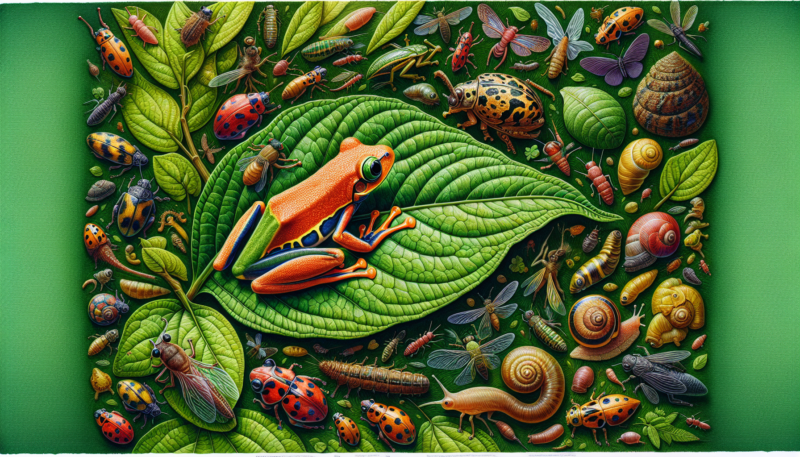Are you curious about what tree frogs eat? Well, you’re in luck! This article will unveil the fascinating diet of a tree frog, shedding light on the various creatures and plants that make up their menu. From insects to small vertebrates, these tiny amphibians have a diverse palate that will leave you amazed. So, get ready to embark on a culinary journey and discover the wonderful world of a tree frog’s diet.
Diet of a Tree Frog
Overview
Tree frogs have a varied and interesting diet that primarily consists of insects, arachnids, snails and slugs, small fish, invertebrates, fruits and flowers, and nectar. However, the specific diet of a tree frog can vary depending on the species, geographical location, and seasonal influences. In this comprehensive article, we will explore each aspect of a tree frog’s diet and the factors that affect its composition.
Insects
Insects are the primary food source for tree frogs and play a crucial role in their diet. These amphibians are voracious insectivores, consuming a wide variety of insects such as leafhoppers, crickets, beetles, caterpillars, mosquitoes, and dragonflies. Tree frogs are highly skilled hunters and use their long, sticky tongues to catch their prey in a swift and precise manner.
Arachnids
In addition to insects, tree frogs also consume arachnids like spiders and scorpions. While spiders are more commonly found in their diet, scorpions are occasionally consumed as well. Tree frogs possess a specialized diet and are equipped to handle the unique challenges of hunting and consuming arachnids.

Snails and Slugs
Tree frogs are known to prey on snails and slugs, which are mollusks. These slimy creatures provide tree frogs with a valuable source of nutrition, particularly calcium. Calcium is essential for the development and maintenance of strong bones and eggs in female tree frogs, making the consumption of snails and slugs an important part of their diet.
Small Fish
Some tree frog species have evolved to include small fish in their diet. These amphibians are adept at catching fish in aquatic environments using their agility and hunting technique. Small fish provide an additional source of protein-rich food for tree frogs, contributing to their overall nutrition.
Invertebrates
Apart from insects, arachnids, snails, and slugs, tree frogs also consume a variety of other invertebrates. This category includes crustaceans, worms, and additional types of mollusks. The ability to consume a diverse range of invertebrates allows tree frogs to adapt to different environments and maintain a balanced diet.

Small Vertebrates
While insects and invertebrates form the majority of their diet, tree frogs occasionally consume small vertebrates. This can include smaller frogs and tadpoles, lizards, geckos, and even birds. Tree frogs employ a strategic hunting strategy to catch these vertebrates, relying on their agility and camouflage to surprise their prey.
Fruits and Flowers
Supplementing their diet with plant matter, tree frogs also consume fruits and flowers. This addition to their diet offers valuable vitamins and nutrients as well as hydration. Tree frogs feed on a variety of fruits and flowers, and the frequency of this consumption varies depending on the availability of these food sources in their habitat.
Nectar
Nectar is another important dietary component for some tree frog species. They have adapted specialized tongues and feeding structures to extract nectar from flowers. Nectar provides a source of energy-rich sugars and carbohydrates for these amphibians. It also plays a role in pollination as tree frogs inadvertently transfer pollen from flower to flower.
Diet Variations
Tree frog diets can vary significantly between different species, geographical locations, and seasons. Each species may have specific dietary preferences based on its habitat and adaptations. Geographical and seasonal influences also affect the availability of certain prey items, leading to variations in their diet. Additionally, captive-bred tree frogs may have slightly different dietary requirements and preferences compared to their wild counterparts.
Species-Specific Diets
Different tree frog species display variations in their dietary preferences. Some species may rely more heavily on certain types of prey, such as insects or small vertebrates, while others may have a broader diet that includes a wider range of food sources. This emphasizes the importance of understanding the specific needs of each tree frog species when providing them with an appropriate diet in captivity.
Geographical and Seasonal Influences
The habitat and geographical location of a tree frog can greatly influence its diet. Tree frogs living in tropical rainforests may have access to a greater variety of prey compared to those in more arid or temperate environments. Similarly, seasonal changes in food availability can impact their diet, with some prey becoming more abundant or scarce during different times of the year.
Captive-Bred Tree Frogs and Diet
Captive-bred tree frogs often have different dietary requirements compared to their wild counterparts. These frogs may be bred in captivity for conservation purposes or as pets. It is important for owners and breeders to understand the specific dietary needs of their captive-bred tree frogs and provide them with a balanced diet that closely mimics their natural food sources.
Effects of Diet on Health and Behavior
A balanced and nutritious diet is crucial for the overall health and well-being of tree frogs. The composition of their diet can directly impact their growth, reproductive success, and immune system function. Inadequate nutrition can lead to various health issues, such as metabolic bone disease and weakened immune defenses. Additionally, a deficient or imbalanced diet may affect their behavior and ability to thrive in their natural habitat or captivity.
In conclusion, the diet of a tree frog is diverse and adaptable, encompassing a wide range of prey items such as insects, arachnids, snails and slugs, small fish, invertebrates, fruits and flowers, and nectar. Understanding the specific dietary preferences and requirements of tree frogs is essential for their proper care and conservation. By providing them with a balanced and varied diet, we can ensure their continued health and well-being in both natural and captive environments.
